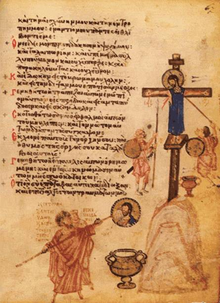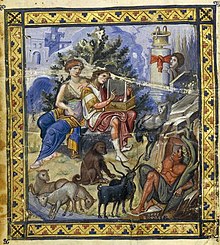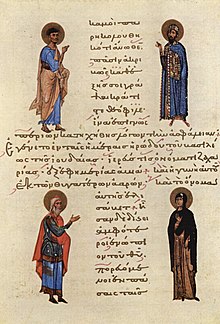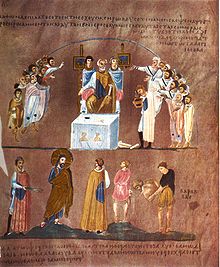Byzantine illumination
The Byzantine Illumination evolved from the Illumination of late antiquity and continued this continued immediately. With the fall of Constantinople in 1453 , the Byzantine Empire and with it its art perished.
Historical conditions

The Byzantine state, which had been dominated by Christianity and Greek since the 7th century , was culturally and politically completely dominated by its metropolis Constantinople , founded in 324/330 , where the imperial court was the most important client.
In contrast to Western and Central Europe, Byzantine art continued the ancient legacy of the former Eastern Roman Empire until its end in the 15th century without interruption, albeit with waves of renewal. An important turning point for art was the Byzantine picture dispute, which suppressed the religious cult of pictures between 726 and 843 before Byzantine art experienced a new heyday from the ninth to the eleventh century. Compared to the multitude of styles and epochs of Western book illumination , Byzantine illumination , despite this temporary break, is characterized by homogeneity, continuity and the insistence on ancient imagery.
All of the renaissance of Western art, be it Carolingian , Ottonian or early modern times, owe essential impulses to Byzantine art. Illumination played an essential role as a mediator, because only the book medium made its way directly to the West and could be copied there in the scriptoria . Byzantine artists were also partly active in the occidental studios.
With the Exarchate of Ravenna and the Catepanate of Italy , Byzantium had important bridgeheads in the west until the 8th century. The cultural exchange later took place through the Republic of Venice , an important ally and trading partner. Only with the defeat of the Byzantine Empire by the fourth crusade , in which against the protest of Pope Innocent III. Constantinople was captured and looted in 1204 and through which Byzantine art experienced a significant slump, the contacts largely broke off. Another consequence was the dismemberment.
While the Slavs in the north and east could be Christianized in the 9th and 10th centuries and brought under the influence of Constantinople, attacks in the east and south first by the Persians , then the Arabs, as well as the Bulgarians , Mongols and Turks presented a constant threat Centuries of struggle for existence, the Byzantine Empire finally collapsed in 1453 with the fall of Constantinople . As a result, many Byzantine scholars fled to Italy with numerous ancient and Byzantine books. In Constantinople, a large part of the works of art fell victim to the looting and destruction of the conquerors.
Constantinople and the Byzantine Empire

In terms of style, ancient and Byzantine art cannot be clearly separated from one another. Usually the epoch of Justinian I (527-565) is regarded as the beginning and first high point of Byzantine art, since Constantinople now became the defining reservoir for all artistic forces of the entire empire who had their most important patron in the emperor. The epoch known as the Justinian Renaissance was characterized by a productive renovatio of the classical language of forms, which merged the various currents of post-ancient art into one unit. The aesthetic character of Justinian art remained exemplary for Byzantine art for centuries.

During the time of the Byzantine picture dispute in the 8th and 9th centuries, liturgical book illumination was limited to crosses and ornaments. Only a few religiously illustrated manuscripts have come down to us, such as the Chludow Psalter , which can be dated between 780 and 815 , and which may have been written around the Patriarch Nikephoros of Constantinople with polemical figures on the margins. The illustration of secular subjects, on the other hand, was apparently not affected by iconoclasm . Nevertheless, the tradition tore so far that illustrations from church books after 843 with stiff figures, mask-like faces and a linear style of folds initially could not match the earlier quality.
After the picture dispute, the illustrators reverted to the collection of illustrated books from the late antique-early Christian period. Illumination gained new impetus from Basil I under the Macedonian dynasty , after which this artistic epoch was given the name “ Macedonian Renaissance ”. The 10th century produced masterpieces whose characteristics were landscapes with atmosphere, expressive, painterly designed faces and a classic canon of figures. The individually designed illustrations succeeded in creating their own creations in the spirit of antiquity, without slavishly copying traditional templates.
Around the year 1000, Byzantine illumination left the naturalistic and elegant style of the Macedonian Renaissance adopted from antiquity. The now prevailing mode is characterized by sharply contoured faces and robes, mannered movements, inorganic, overlong shapes, unrealistic landscapes and architectures as well as an extensive renunciation of physicality and spatial depth.
Areas of influence of Byzantine art
The Byzantine tradition is embodied to this day mainly by the Orthodox and ancient Near Eastern churches , which are based directly on the Byzantine rite .
Middle East
An example of the stylistic continuity between late antique and pre-Islamic Syrian illumination is the Codex purpureus Rossanensis , created in the 6th century . In Zagba in Mesopotamia , the Rabbula Gospel was created in 586 , the illustrations of which differ from Byzantine art in their linear flatness. The canon tables were decisive for the subsequent illumination , until figurative illustrations were used again in the 11th century, which were mainly influenced by Byzantium, but also by Islamic book art and the art of the Crusader states . The development of a uniform Syrian style was prevented by the splitting of the Christian minorities into Jacobites , Maronites , Melchites and Nestorians .
The early Armenian book illumination is also an oriental variant of Byzantine art, which was influenced by Syrian but also by Coptic and occasionally by Western painting. With the exception of a fragment of a gospel, which possibly dates from the 7th century, tradition began to a greater extent in the 10th century. In the 11th century, schools of illumination emerged in Turuberan , Sebaste and possibly a court school in Kars . Few illuminated manuscripts have survived from the 12th century whose very linear style shows a dwindling influence of Byzantium. The manuscripts of the 13th century show very strong differences and the most varied of influences. The outstanding Armenian illuminator was Toros Roslin , of whom seven signed manuscripts have survived from the years 1256–1268, five of which were created in the Armenian Patriarchate of Jerusalem . Six other manuscripts are ascribed to him because of their high quality. In the 13th and 14th centuries, this climax was followed by a breakdown into a wide variety of styles.
In Georgia , which was nominally under Byzantine suzerainty, Byzantine influence was particularly dominant. The first illuminated manuscripts date from the 9th and 10th centuries. With the decline of Byzantium, Georgian book illumination also sank to a modest, provincial level.
Balkans and Old Russia

Traditional Serbian book illumination began towards the end of the 12th century and mixed the cultural influences of Byzantium and the Latin West. In the 14th century the art of Serbia turned to the whole of Byzantium and reached its peak at the same time.
The Bulgarian Illumination experienced under Tsar Ivan Alexander in the 14th century in the school of Tarnovo its second bloom in a very strong byzantinisierenden style after until then had been mostly designed purely ornamental illuminations created. In the 15th century, after the conquest of Bulgaria by the Ottoman Turks, figurative painting disappears again from Bulgarian book illumination and the illuminations are limited to artistic ornamentation and traditional zoomorphic motifs from the times of the First Bulgarian Empire until the 16th century.
Romanian illuminations only appear around 1400 and are entirely part of late Byzantine art. The masterpieces of Romanian book art were created under Stefan the Great around 1500.
In Old Russia , the reception of Byzantine book illumination gave rise to its own style. Novgorod and Kiev were important centers of art for early Russian illumination . Approaches to a reception of Western book art could not develop due to Mongol invasions and annexations by Lithuania in the 13th and 14th centuries. Around 1200 production centers appeared in Rostov , Yaroslavl , Suzdal and elsewhere.
Copts
Main article: Coptic art
Egyptian tradition evolved into Nubia and Ethiopia , the Christian art of the Copts . Influenced by Byzantine painting, it remained largely isolated and sealed off due to its marginal or island position, especially after the invasion of the Arabs in 641. A gospel book illustrated in Damiette in 1180 shows that influences of Arab art also had an impact on Coptic book illumination.
In continuity of style with isolated secular papyrus fragments from the 5th century, the first Christian illumination in the form of a depiction of Job has come down to us from the 7th century. Upper Egyptian Sahidic manuscripts of the 8th to 10th centuries have strict frontality, pure flatness, linear folds and faces with large, staring eyes in common. A common iconographic motif in these manuscripts is the Maria lactans . This is completely lacking in the later Bohairian manuscripts from Lower Egypt . This illumination flourished when it was influenced by Byzantine art from the late 12th to the end of the 13th century.
See also
literature
- K. Beer brewer, Ø. Hjort, O. Mazal, D. Thoss, G. Dogaer, J. Backhouse, G. Dalli Regoli, H. Künzl: Illumination . In: Lexicon of the Middle Ages (LexMA). Volume 2, Artemis & Winkler, Munich / Zurich 1983, ISBN 3-7608-8902-6 , Sp. 837-893.
- Ingo F. Walther / Norbert Wolf: Codices illustres. The most beautiful illuminated manuscripts in the world. Masterpieces of book illumination. 400 to 1600 . Taschen, Cologne et al. 2005, ISBN 3-8228-4747-X .
Web links
supporting documents
- ^ Paris, Bibliothèque nationale, Ms. gr. 139, 1v.
- ↑ Moscow, Hist. Mus. MS. gr.129d.
- ↑ LexMa Sp. 868.
- ^ So the Princeton manuscript, University Library, Ms. Garett 6.
- ^ Paris, Bibliothèque Nationale.
- ↑ Florence, Laurenziana, Plut. I, 56.
- ↑ Yerevan, Matendaran, Ms. 10675.
- ↑ LexMA, Col. 881.
- ↑ LexMA, Col. 882.
- ^ Saint Petersburg, Russian National Library .
- ^ British Library Add. MS 59874
- ^ Paris, Bibliothèque nationale, Ms. copte 13.
- ↑ Naples, Bibl. Naz., Ms. IB 18.



